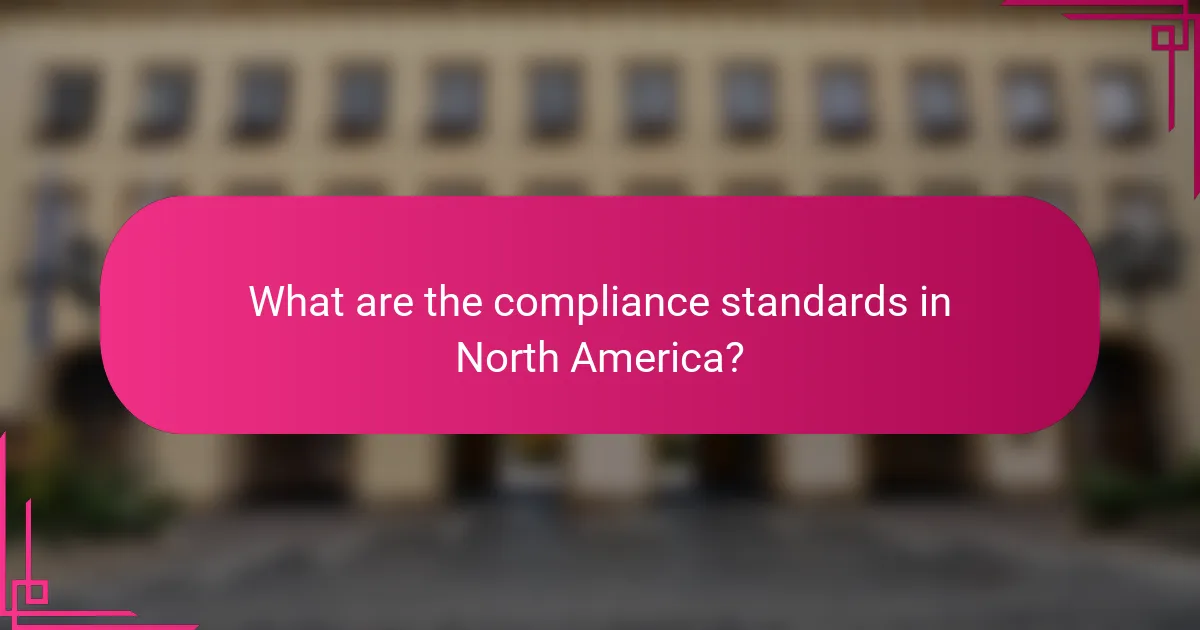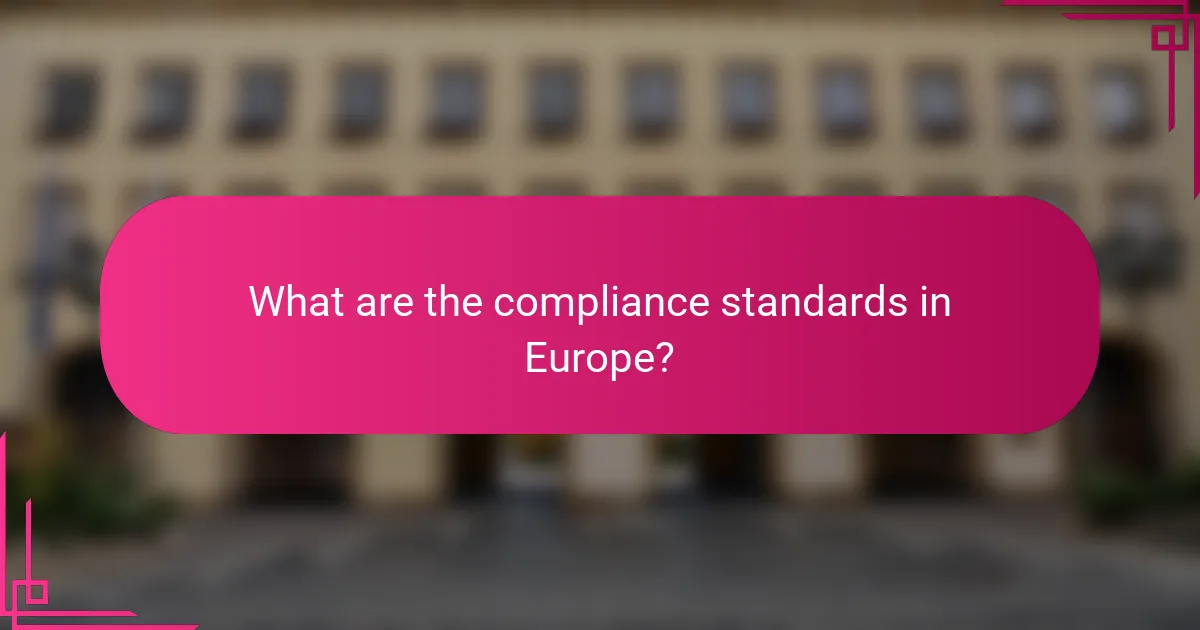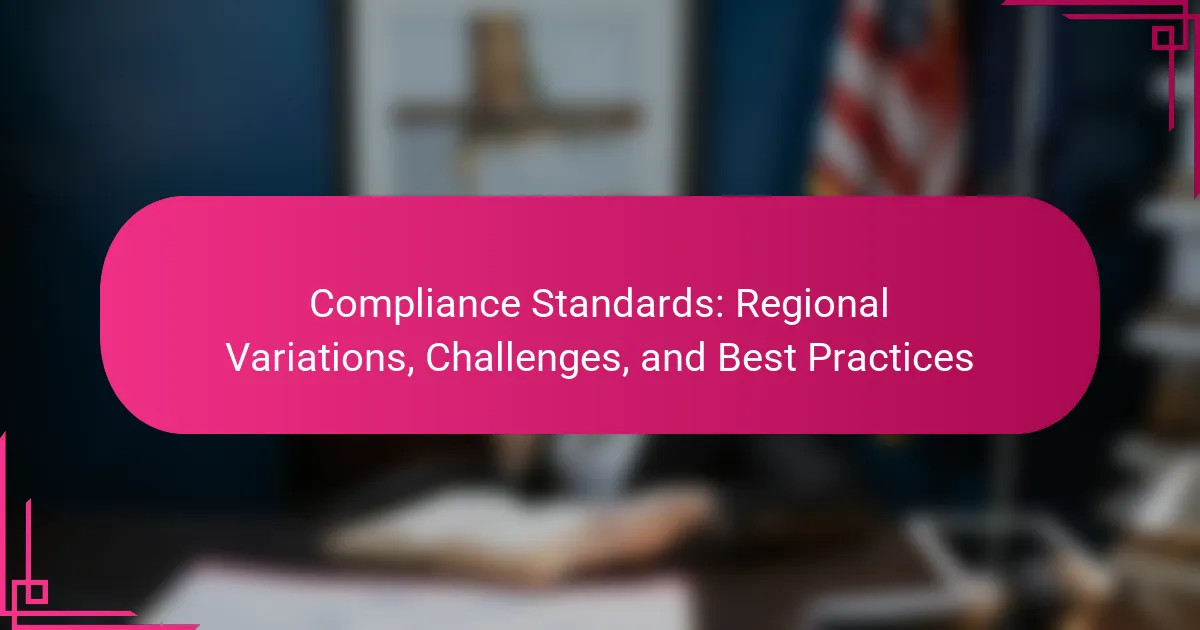Compliance standards vary significantly across regions, reflecting diverse regulatory environments and cultural priorities. In North America, regulations like HIPAA and GLBA focus on data protection and operational integrity, while Europe emphasizes consumer rights through frameworks such as GDPR and PSD2. Organizations face challenges in adapting to these standards, including navigating complex regulations and managing resources effectively, which can impact their operational efficiency and compliance risk.

What are the compliance standards in North America?
Compliance standards in North America are regulations that organizations must adhere to in order to protect sensitive information and ensure operational integrity. Key standards include the Health Insurance Portability and Accountability Act (HIPAA), the Gramm-Leach-Bliley Act (GLBA), and the Federal Information Security Management Act (FISMA), each addressing different aspects of data protection and privacy.
Health Insurance Portability and Accountability Act (HIPAA)
HIPAA is a federal law designed to protect patient health information in the United States. It establishes national standards for the privacy and security of health data, requiring healthcare providers, insurers, and their business associates to implement safeguards to protect sensitive information.
Organizations must conduct risk assessments, train employees on data privacy, and ensure that any electronic health records systems comply with HIPAA regulations. Non-compliance can result in significant fines, often ranging from thousands to millions of dollars depending on the severity of the violation.
Gramm-Leach-Bliley Act (GLBA)
The GLBA mandates that financial institutions protect consumers’ personal financial information. It requires these institutions to provide privacy notices to customers and to implement measures to safeguard sensitive data from unauthorized access.
Organizations must develop a written information security plan, conduct regular risk assessments, and ensure that third-party service providers also comply with GLBA requirements. Failure to adhere to these regulations can lead to penalties and loss of customer trust.
Federal Information Security Management Act (FISMA)
FISMA requires federal agencies and their contractors to secure information systems and data. It establishes a framework for managing information security risks and mandates regular assessments and reporting on the effectiveness of security controls.
Agencies must develop, document, and implement an information security program that includes continuous monitoring and incident response plans. Compliance with FISMA is essential for maintaining federal funding and ensuring the integrity of government operations.

What are the compliance standards in Europe?
Compliance standards in Europe are designed to protect consumer rights and ensure data security across various sectors. Key regulations such as the GDPR, PSD2, and ePrivacy Directive set specific requirements for businesses operating within the European Union.
General Data Protection Regulation (GDPR)
The General Data Protection Regulation (GDPR) is a comprehensive data protection law that governs how personal data is collected, processed, and stored in the EU. It applies to all organizations that handle the personal data of EU citizens, regardless of where the organization is based.
Under GDPR, businesses must obtain explicit consent from individuals before processing their data and provide them with the right to access, rectify, or delete their information. Non-compliance can result in hefty fines, often reaching up to 4% of annual global turnover or €20 million, whichever is higher.
Payment Services Directive 2 (PSD2)
The Payment Services Directive 2 (PSD2) aims to enhance consumer protection and promote innovation in the payment services sector. It requires banks and payment service providers to open their payment infrastructure to third-party providers, enabling new payment solutions and services.
Key provisions of PSD2 include strong customer authentication (SCA) requirements, which mandate two-factor authentication for online payments. Businesses must ensure they comply with these security measures to avoid penalties and maintain consumer trust.
ePrivacy Directive
The ePrivacy Directive complements the GDPR by focusing specifically on privacy in electronic communications. It governs the use of cookies, direct marketing, and the confidentiality of communications, ensuring that users have control over their personal data.
Under the ePrivacy Directive, organizations must obtain consent before placing cookies on users’ devices and provide clear information about their data practices. Compliance is crucial, as failure to adhere can lead to significant fines and damage to reputation.

What challenges do businesses face with compliance?
Businesses encounter several challenges with compliance, including navigating complex regulations, managing resource allocation, and keeping up with frequent changes. These obstacles can hinder operational efficiency and increase the risk of non-compliance, which can lead to financial penalties and reputational damage.
Complexity of regulations
The complexity of regulations varies significantly by region and industry, making compliance a daunting task for many businesses. Organizations must understand local laws, international standards, and industry-specific requirements, which can be overwhelming. For instance, a company operating in the European Union must comply with GDPR, while a business in the United States may face a patchwork of federal and state regulations.
To navigate this complexity, businesses should invest in compliance management systems that help track regulatory changes and ensure adherence to applicable laws. Regular training for employees on compliance requirements can also mitigate risks associated with misunderstandings or oversights.
Resource allocation issues
Resource allocation is a critical challenge for businesses striving to meet compliance standards. Many organizations struggle to dedicate sufficient financial and human resources to compliance efforts, especially smaller firms with limited budgets. This can lead to inadequate compliance programs and increased vulnerability to violations.
To address resource allocation issues, companies should prioritize compliance in their strategic planning. This may involve reallocating funds from less critical areas or leveraging technology to automate compliance processes, thus reducing the need for extensive manual oversight.
Keeping up with changes
Keeping up with changes in compliance regulations is essential but often challenging. Regulations can evolve rapidly due to shifts in government policy, technological advancements, or industry practices. Businesses that fail to stay informed risk falling behind and facing penalties.
To effectively keep up with changes, organizations should establish a system for monitoring regulatory updates, such as subscribing to industry newsletters or joining professional associations. Regular audits of compliance practices can also help identify areas needing adjustment in response to new regulations.

What best practices can enhance compliance?
To enhance compliance, organizations should focus on regular training, effective management software, and consistent audits. These practices help ensure that employees understand regulations and that the organization adheres to necessary standards.
Regular training programs
Regular training programs are essential for keeping employees informed about compliance requirements and updates. These sessions should be tailored to specific roles within the organization, ensuring that all staff understand their responsibilities regarding compliance.
Consider implementing a schedule that includes initial training for new hires and ongoing sessions at least annually. Incorporating interactive elements, such as quizzes or case studies, can enhance engagement and retention of information.
Implementing compliance management software
Compliance management software streamlines the process of tracking regulations and managing compliance tasks. This type of software can automate reporting, monitor compliance status, and provide alerts for upcoming deadlines, significantly reducing the risk of oversight.
When selecting software, look for features that align with your organization’s specific compliance needs. Consider platforms that offer user-friendly interfaces and robust customer support to facilitate smooth implementation and ongoing use.
Conducting regular audits
Regular audits are crucial for assessing compliance effectiveness and identifying areas for improvement. These audits should be scheduled at least quarterly and can include both internal reviews and external assessments to provide a comprehensive view of compliance status.
During audits, focus on key compliance areas such as data protection, financial reporting, and industry-specific regulations. Establish clear criteria for evaluation and document findings to inform future compliance strategies and training initiatives.

How do compliance standards vary by industry?
Compliance standards differ significantly across industries due to varying regulatory requirements, operational risks, and stakeholder expectations. Each sector must navigate its unique landscape of laws and guidelines to ensure adherence and mitigate risks.
Healthcare compliance requirements
Healthcare compliance is primarily governed by regulations such as HIPAA in the United States, which mandates the protection of patient information. Organizations must implement robust privacy policies, conduct regular training, and maintain thorough documentation to comply with these standards.
Additionally, healthcare providers must adhere to quality standards set by organizations like The Joint Commission. Regular audits and assessments are essential to ensure compliance and improve patient care outcomes.
Financial services regulations
In the financial services sector, compliance is driven by regulations such as the Dodd-Frank Act and the Basel III framework. These regulations focus on risk management, capital adequacy, and consumer protection, requiring firms to implement comprehensive compliance programs.
Financial institutions must conduct regular risk assessments and maintain transparent reporting practices to meet regulatory expectations. Non-compliance can lead to significant penalties and reputational damage.
Manufacturing safety standards
Manufacturing safety standards are often dictated by regulations such as OSHA in the United States, which sets forth requirements for workplace safety and health. Companies must ensure that their facilities comply with safety protocols to protect workers and avoid legal repercussions.
Implementing safety training programs and conducting regular inspections can help manufacturers maintain compliance. Additionally, adhering to ISO standards can enhance product quality and operational efficiency, further supporting compliance efforts.
